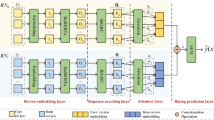Abstract
With the rapid development of the internet, users tend to refer to the rating scores or review opinions on social platforms. Most recommendation systems use collaborative filtering (CF) methods to recommend items based on users’ ratings. The rating-based CF methods do not consider users’ review opinions on different aspects of items. The accuracy of the rating predictions can be effectively improved by considering the latent semantics and various aspects of user reviews. In this paper, a novel rating prediction method is proposed according to an attention-based gated recurrent unit (GRU) deep learning model with semantic aspects. A two-phase method is proposed herein; it combines the word attention mechanism and review semantics to extract aspect features from user preferences. In the first phase, a bidirectional GRU neural network is adopted according to word attention in order to extract important words from users’ reviews. In the second phase, we split users’ reviews into words, and generate the aspect-based attention semantic vectors from these reviews based on Latent Dirichlet Allocation and the attention weights of the chosen words. The XGBoost method is then adopted to predict user preference ratings based on the aspect-based attention semantic vectors. The experimental results show that the proposed method outperforms traditional prediction methods and effectively improves the accuracy of predictions.








Similar content being viewed by others
References
Adomavicius G, Tuzhilin A (2005) Toward the next generation of recommender systems: a survey of the state-of-the-art and possible extensions. IEEE Trans Knowl Data Eng 17:734–749
Al-Smadi M, Talafha B, Al-Ayyoub M, Jararweh Y (2018) Using long short-term memory deep neural networks for aspect-based sentiment analysis of Arabic reviews. Int J Mach Learn Cybern. https://doi.org/10.1007/s13042-018-0799-4
Bagheri A, Saraee M, De Jong F (2013) Care more about customers: unsupervised domain-independent aspect detection for sentiment analysis of customer reviews. Knowl Based Syst 52:201–213
Bahdanau D, Cho K, Bengio Y (2015) Neural machine translation by jointly learning to align and translate. In: International conference on learning representations
Blei DM, Ng AY, Jordan MI (2003) Latent Dirichlet Allocation. J Mach Learn Res 3:993–1022
Bottou L (2010) Large-scale machine learning with stochastic gradient descent. In: Proceedings of the international conference on computational statistics (COMPSTAT). Physica-Verlag HD, pp 177–186
Brody S, Elhadad NA (2010) Unsupervised aspect-sentiment model for online reviews. In: Human language technologies: the 2010 annual conference of the North American chapter of the association for computational linguistics, Los Angeles, California Association for Computational Linguistics, pp 804–812
Chen T, Guestrin C (2016) Xgboost: a scalable tree boosting system. In: Proceedings of the 22nd ACM SIGKDD international conference on knowledge discovery and data mining, San Francisco, California, USA. ACM, pp 785–794
Cho K, Van Merriënboer B, Gulcehre C et al (2014) Learning phrase representations using RNN encoder–decoder for statistical machine translation. In: Proceedings of the conference on empirical methods in natural language processing (EMNLP) Doha, Qatar. pp 1724–1734
Da’u A, Salim N, Rabiu I, Osman A (2020) Recommendation system exploiting aspect-based opinion mining with deep learning method. Inf Sci 512:1279–1292. doi:https://doi.org/10.1016/j.ins.2019.10.038
Dong R, Schaal M, O’Mahony MP, Smyth B (2013) Topic extraction from online reviews for classification and recommendation. In: Proceedings of the twenty-third international joint conference on artificial intelligence, Beijing, China. pp 1310–1316
Ganu G, Elhadad N, Marian A (2009) Beyond the stars: improving rating predictions using review text content. In: Twelfth international workshop on the web and databases Providence, Rhode Island, USA. pp 1–6
Gong S (2010) A collaborative filtering recommendation algorithm based on user clustering and item clustering. J Softw 5:745–752
Hinton G, Deng L, Yu D et al (2012) Deep neural networks for acoustic modeling in speech recognition: the shared views of four research groups. IEEE Signal Proc Mag 29:82–97
Hochreiter S, Schmidhuber J (1997) Long short-term memory. Neural Comput 9:1735–1780
Hopfield JJ (1982) Neural networks and physical systems with emergent collective computational abilities. In: Proceedings of the national academy of sciences of the United States of America, vol 8. pp 2554–2558
Hu M, Liu B (2004) Mining and summarizing customer reviews. In: Proceedings of the tenth ACM SIGKDD international conference on knowledge discovery and data mining, Seattle, WA, USA. ACM, pp 168–177
Huang J, Rogers S, Joo E (2014) Improving restaurants by extracting subtopics from Yelp reviews. In: iConference 2014 (Social Media Expo)
Jo Y, Oh AH (2011) Aspect and sentiment unification model for online review analysis. In: Proceedings of the fourth ACM international conference on web search and data mining, Hong Kong, China ACM, pp 815–824
Kanungo T, Mount DM, Netanyahu NS et al (2002) An efficient k-means clustering algorithm: analysis and implementation. IEEE Trans Pattern Anal 24:881–892
Kim Y (2014) Convolutional neural networks for sentence classification. In: Proceedings of the conference on empirical methods in natural language processing (EMNLP) Doha, Qatar. pp 1746–1751
Koren Y, Bell R, Volinsky C (2009) Matrix factorization techniques for recommender systems. Computer 42:30–37. https://doi.org/10.1109/MC.2009.263
Krizhevsky A, Sutskever I, Hinton GE (2012) ImageNet classification with deep convolutional neural networks. In: The 25th international conference on neural information processing systems, Lake Tahoe, Nevada, pp 1097–1105
Ling G, Lyu MR, King I (2014) Ratings meet reviews, a combined approach to recommend. In: Proceedings of the 8th ACM conference on recommender systems, Foster City, Silicon Valley, California, USA. ACM, pp 105–112
Lipton ZC, Berkowitz J, Elkan C (2015) A critical review of recurrent neural networks for sequence learning. arXiv preprint arXiv:150600019
Liu B, Hu M, Cheng J (2005) Opinion observer: analyzing and comparing opinions on the web. In: Proceedings of the 14th international conference on world wide web, Chiba, Japan. ACM, pp 342–351
Liu D-R, Chen K-Y, Chou Y-C, Lee J-H (2018) Online recommendations based on dynamic adjustment of recommendation lists. Knowl Based Syst 161:375–389
Lops P, De Gemmis M, Semeraro G (2011) Content-based recommender systems: state of the art and trends. In: Ricci F, Rokach L, Shapira B, Kantor PB (eds) Recommender systems handbook. Springer, Boston, pp 73–105
Lu B, Ott M, Cardie C, Tsou BK (2011) Multi-aspect sentiment analysis with topic models. In: The IEEE 11th international conference on data mining workshops (ICDMW), Vancouver, Canada. IEEE, pp 81–88
McAuley J, Leskovec JH (2013) Factors and hidden topics: understanding rating dimensions with review text. In: Proceedings of the 7th ACM conference on recommender systems, Hong Kong, China. ACM, pp 165–172
Pennington J, Socher R, Manning C (2014) Glove: Global vectors for word representation. In: Proceedings of the conference on empirical methods in natural language processing (EMNLP), Doha, Qatar. Association for Computational Linguistics, pp 1532–1543
Qiao X, Peng C, Liu Z, Hu Y (2019) Word-character attention model for Chinese text classification. Int J Mach Learn Cybern. https://doi.org/10.1007/s13042-019-00942-5
Sarwar B, Karypis G, Konstan J, Riedl J (2001) Item-based collaborative filtering recommendation algorithms. In: Proceedings of the 10th international conference on world wide web, Hong Kong, China. ACM, pp 285–295
Seo S, Huang J, Yang H, Liu Y (2017) Interpretable convolutional neural networks with dual local and global attention for review rating prediction. In: Proceedings of the eleventh ACM conference on recommender systems, Como, Italy. ACM, pp 297–305
Seo S, Huang J, Yang H, Liu Y (2017) Representation learning of users and items for review rating prediction using attention-based convolutional neural network. In: 3rd International workshop on machine learning methods for recommender systems (MLRec)
Serrano-Guerrero J, Chiclana F, Olivas JA et al (2020) A T1OWA fuzzy linguistic aggregation methodology for searching feature-based opinions. Knowl Based Syst 189:105131. https://doi.org/10.1016/j.knosys.2019.105131
Serrano-Guerrero J, Olivas JA, Romero FP, Herrera-Viedma E (2015) Sentiment analysis: a review and comparative analysis of web services. Inf Sci 311:18–38. https://doi.org/10.1016/j.ins.2015.03.040
Socher R, Perelygin A, Wu J et al (2013) Recursive deep models for semantic compositionality over a sentiment treebank. In: Proceedings of the conference on empirical methods in natural language processing, Seattle, Washington, USA. pp 1631–1642
Sun S, Luo C, Chen J (2017) A review of natural language processing techniques for opinion mining systems. Inform Fusion 36:10–25. doi:https://doi.org/10.1016/j.inffus.2016.10.004
Tang D, Qin B, Liu T (2015) Document modeling with gated recurrent neural network for sentiment classification. In: Proceedings of the conference on empirical methods in natural language processing, Lisbon, Portugal. pp 1422–1432
Tang D, Qin B, Liu T, Yang Y (2015) User modeling with neural network for review rating prediction. In: Proceedings of 24th international joint conference on artificial intelligence. pp 1340–1346
Titov I, McDonald R (2008) Modeling online reviews with multi-grain topic models. In: Proceedings of the 17th international conference on world wide web, Beijing, China. ACM, pp 111–120
Wang H, Lu Y, Zhai C (2010) Latent aspect rating analysis on review text data: a rating regression approach. In: Proceedings of the 16th ACM SIGKDD international conference on knowledge discovery and data mining, Washington, DC, USA. ACM, pp 783–792
Wu Y, Ester M (2015) FLAME: a probabilistic model combining aspect based opinion mining and collaborative filtering. In: Proceedings of the eighth ACM international conference on web search and data mining, Shanghai, China. ACM, pp 199–208
Yang Z, Yang D, Dyer C et al (2016) Hierarchical attention networks for document classification. In: Proceedings of the conference of the North American chapter of the association for computational linguistics: human language technologies, San Diego, California, USA. Association for Computational Linguistics, pp 1480–1489
Young T, Hazarika D, Poria S, Cambria E (2018) Recent trends in deep learning based natural language processing. IEEE Comput Intell Mag 13:55–75. https://doi.org/10.1109/MCI.2018.2840738
Zhang Y, Wallace B (2015) A sensitivity analysis of (and practitioners’ guide to) convolutional neural networks for sentence classification. In: Proceedings of the 8th international joint conference on natural language processing, Taipei, Taiwan. pp 253–263
Zheng L, Noroozi V, Yu PS (2017) Joint deep modeling of users and items using reviews for recommendation. In: Proceedings of the tenth ACM international conference on web search and data mining, Cambridge, United Kingdom. ACM, pp 425–434
Zhuang L, Schouten K, Frasincar F (2020) SOBA: semi-automated ontology builder for aspect-based sentiment analysis. J Web Semant 60:100544. https://doi.org/10.1016/j.websem.2019.100544
Acknowledgements
This research was supported by the Ministry of Science and Technology of Taiwan under Grant number: MOST 105-2410-H-009-033-MY3 and MOST 106-2410-H-033-013.
Author information
Authors and Affiliations
Corresponding author
Additional information
Publisher's Note
Springer Nature remains neutral with regard to jurisdictional claims in published maps and institutional affiliations.
Rights and permissions
About this article
Cite this article
Lai, CH., Liu, DR. & Lien, KS. A hybrid of XGBoost and aspect-based review mining with attention neural network for user preference prediction. Int. J. Mach. Learn. & Cyber. 12, 1203–1217 (2021). https://doi.org/10.1007/s13042-020-01229-w
Received:
Accepted:
Published:
Issue Date:
DOI: https://doi.org/10.1007/s13042-020-01229-w




